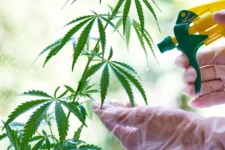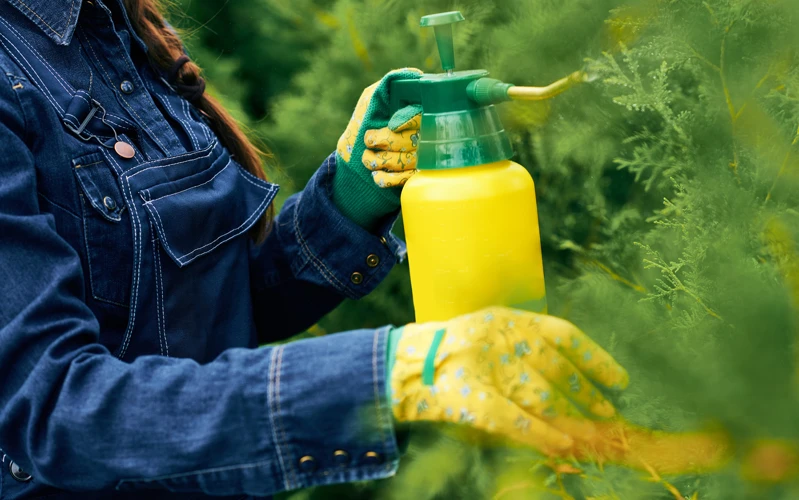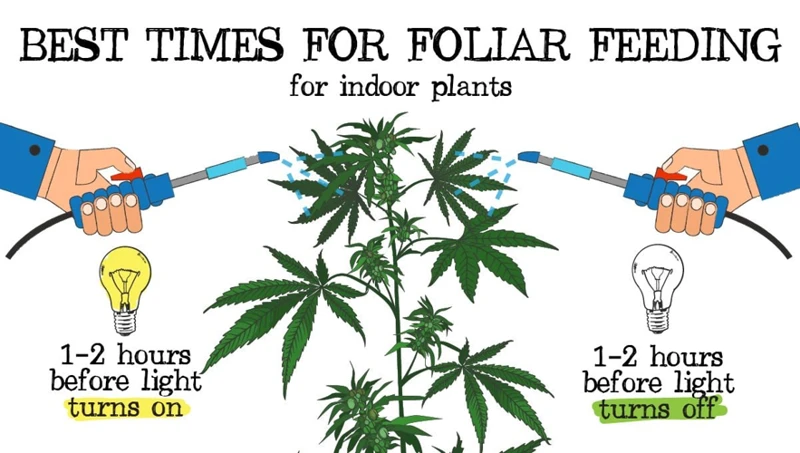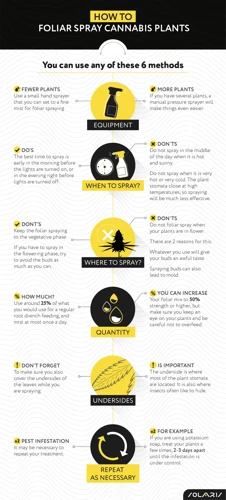
Optimal Timing for Foliar Spray Application on Cannabis Plants
Introduction to Foliar Spray Application on Cannabis Plants
Contents
Foliar spray application is an effective method of providing essential nutrients, vitamins, and minerals to cannabis plants. Foliar spraying involves applying a nutrient-rich solution directly onto the leaves of the plant, allowing it to absorb the nutrients through the stomata. This method of feeding the plant is especially useful when the soil is lacking in certain nutrients or when the plant is experiencing stress due to unfavorable growing conditions.
The practice of foliar spraying has been widely adopted by marijuana growers as a means of promoting the growth and development of their plants. However, timing and proper application techniques are critical factors that determine the success of this method. A well-timed foliar spray can have a notable impact on the plant’s overall health, while a poorly timed application can lead to detrimental effects such as burning of the foliage.
In this article, we will delve into the best practices for foliar spraying cannabis plants, focusing on its importance and appropriate timing. We will also provide a comprehensive guide on choosing the right product, preparation for application, the application process, as well as post-application care to ensure that your plant receives optimal benefits from foliar spraying.
Why Timing is Important for Foliar Spraying
The timing of foliar spray application is a crucial factor in ensuring the healthy growth and development of your cannabis plants. Inaccurate timing of foliar spraying can result in ineffective absorption of the product, reduced yields, and in some cases, plant damage. To avoid these complications, it is important to understand the growth stages of your plants, as well as the factors that affect the absorption of foliar spray. By following the appropriate timing guidelines, you can maximize the benefits of foliar spraying and help your plants flourish.
Understanding the Plant Growth Stages
It’s crucial to understand the different plant growth stages to determine the appropriate timing for foliar spray application on cannabis plants. There are two main stages: the vegetative stage and the flowering stage.
Vegetative Stage: During this stage, the plant is focused on developing its stem, branches, and leaves. It’s when the plant exhibits the most growth, and its energy goes towards the creation of the photosynthetic machinery. The vegetative stage can last anywhere from 3 to 16 weeks, depending on the strain and growing conditions.
Flowering Stage: This stage starts once the plant has matured enough to develop flowers, which will eventually become buds. During this stage, the plant’s focus shifts from growth to reproduction. The flowering stage can last anywhere from 6 to 12 weeks, depending on the strain and growing conditions.
It’s important to note that different strains may have different growth patterns and timeline. Factors that may affect the speed of growth include genetics, environmental factors, and the growing conditions.
By understanding the different growth stages of cannabis plants, growers can better determine the optimal time for foliar spray application. In the next section, we’ll discuss the various factors affecting absorption of foliar spray, which is another important consideration when determining the timing of application.
| Plant Growth Stage | Description |
|——————-|——————————————————————————————————————————————-|
| Vegetative Stage | Plant focuses on developing its stem, branches, and leaves. Energy goes towards the creation of the photosynthetic machinery. Can last 3-16 weeks. |
| Flowering Stage | Plant’s focus shifts from growth to reproduction. Starts once the plant has matured enough to develop flowers. Can last 6-12 weeks. |
Factors Affecting Absorption of Foliar Spray
The effectiveness of foliar spray application is greatly influenced by several factors that affect the absorption of the spray by the plant. It is important to understand these factors in order to achieve the desired results from foliar spraying.
One of the most important factors affecting the absorption of foliar spray is temperature. The ideal temperature range for foliar spraying is between 18-27°C (65-80°F). Temperatures outside of this range can reduce the absorption rate or cause damage to the leaves.
Another important factor is the pH level of the spray solution. The ideal pH range is between 5.5-6.5. Solutions that are too acidic or too alkaline can reduce the effectiveness of the spray and damage the plant.
The quality of the water used in the spray solution can also affect absorption. Hard water with high mineral content can reduce absorption and cause leaf burn. Using distilled or purified water can prevent these issues and promote better absorption.
The timing of the spray application is important. Spraying during periods of high humidity can cause the spray to sit on the leaves and reduce absorption. It is best to spray during periods of low humidity and when there is adequate air movement.
Lastly, the type of spray product used can also affect absorption. Some products may require a higher concentration for effective absorption, while others may need to be diluted. It is important to follow the manufacturer’s instructions for proper application.
It is important to consider these factors when applying foliar spray to cannabis plants in order to maximize absorption and achieve optimal results.
| Factors Influencing Absorption of Foliar Spray |
|---|
| Temperature |
| pH level of spray solution |
| Quality of water used in spray solution |
| Timing of spray application |
| Type of spray product used |
When to Apply Foliar Spray to Cannabis Plants
One of the most important aspects of foliar spraying on cannabis plants is timing. It’s a crucial factor that can determine the effectiveness of the application and the overall health and growth of the plants. But with different growth stages and varying factors affecting absorption, it can be perplexing to determine the best time to apply foliar spray. In this section, we’ll explore the ideal timing for foliar application during the different growth stages of cannabis plants.
Vegetative Stage
During the vegetative stage of cannabis growth, the plant is focused on developing its leaves, branches, and roots. This stage begins immediately after the seedling stage and lasts until the plant begins to produce flowers.
The Best Time for Foliar Spraying:
During the vegetative stage, plants are actively growing and can benefit greatly from foliar spraying. Ideally, foliar sprays should be applied early in the morning or late in the afternoon when the temperature is cooler and the sun is less intense.
Why is Timing Important:
During the vegetative stage, plants are producing large amounts of chlorophyll, which is responsible for photosynthesis. Foliar sprays can help boost chlorophyll production, resulting in increased plant growth and vigor.
Factors Affecting Absorption:
During the vegetative stage, the leaves of cannabis plants are more permeable and can absorb foliar spray more easily. However, humidity levels can affect absorption rates, so it’s important to choose the right time of day to apply foliar spray.
Table: Best Practices for Foliar Spraying during Vegetative Stage
| Factor | Recommendation |
|---|---|
| Time of Day | Early morning or late afternoon |
| Humidity | Avoid spraying during high humidity |
| Frequency | Apply every 2-3 weeks, as needed |
Conclusion:
Foliar spraying during the vegetative stage can help promote healthier and more vigorous growth in cannabis plants. By understanding the factors that affect absorption and choosing the right time of day to apply foliar spray, growers can ensure the best results. It’s important to remember to only apply foliar spray when necessary and not to overdo it, as too much spraying can damage or even kill the plant.
Flowering Stage
During the flowering stage, your cannabis plants will require a different type of foliar spray than during the vegetative stage. This is because your plants’ needs change as they transition from growing leaves and stems to developing buds.
Timing: The best time to apply foliar spray during the flowering stage is early in the morning or late in the evening, when the temperature is cooler and the humidity is higher. This is because during these times your plants are less stressed and will be better able to absorb the spray.
Product: When choosing a foliar spray for the flowering stage, look for a product that is high in phosphorous and potassium. These nutrients are essential for the development of healthy buds and flowers. One such product is a bloom booster, which is specifically designed for use during the flowering stage.
Preparation: Before applying the foliar spray, it’s important to make sure your plants are well hydrated. Water them thoroughly the day before, and avoid applying the spray on hot, sunny days. The high temperature can cause the water to evaporate before the plant has had a chance to absorb it.
Application: When applying the foliar spray, be sure to target the buds and flowers directly. Use a spray bottle or pump sprayer to apply the spray evenly over the entire plant, making sure to cover both the tops and bottoms of the leaves. Avoid spraying too heavily, as this can cause the spray to run off the plant.
Post-Application: After applying the foliar spray, it’s important to monitor your plants closely for any signs of stress. If you notice any wilting, yellowing or other symptoms, stop applying the spray immediately and seek advice from a professional. Additionally, it’s a good idea to rinse your plants with clean water a few hours after applying the spray, to remove any excess residue. This will help prevent any damage to your plants and ensure they remain healthy throughout the flowering stage.
Here is a summary of the key points for applying foliar spray during the flowering stage:
| Timing | Early morning or late evening |
| Product | A bloom booster high in phosphorous and potassium |
| Preparation | Hydrate plants the day before and avoid hot, sunny days |
| Application | Target buds and flowers directly, use spray bottle or pump sprayer, apply evenly |
| Post-Application | Monitor plants for stress symptoms, rinse with clean water a few hours after application |
By following these guidelines, you’ll be able to give your cannabis plants the support they need during the flowering stage and ensure a healthy and bountiful harvest.
Pre-Harvest Stage
The pre-harvest stage is the critical time for cannabis growers to focus on achieving a quality product. During this phase, the plants are typically in their final growth stage, and growers should be careful about applying foliar sprays. At this point, the focus is on optimizing the plant’s nutrient levels and promoting the proper ripening of the buds.
Timing
Timing is vital during the pre-harvest stage because the application of foliar spray products can affect the taste, aroma, and potency of the cannabis buds. Typically, the pre-harvest stage begins three to four weeks before the expected harvest date. At this phase, the plant’s buds are becoming more mature and are producing resinous trichomes which contain the cannabinoids and terpenes responsible for the cannabis plant’s psychoactive and medicinal properties.
What to Avoid
Growers should avoid using foliar sprays that contain heavy elements during this stage, as residue from these products can impact the flavor and aroma of the buds. Heavy elements found in some foliar spray products include copper, sulfur, and iron. Another factor to consider when applying foliar spray at this stage is the presence of pests and other pathogens. Certain foliar spray products can lead to the development of mold or mildew if plants are not adequately protected.
Nutrient Optimization
The primary focus during the pre-harvest stage is on optimizing nutrient levels in the plant. Foliar sprays can be effective at increasing nutrient uptake and aiding plants in utilizing stored nutrients before harvest. Some popular foliar sprays for this stage include those containing high levels of phosphorus and potassium, which promote root growth and aid in the maturation of flowers.
To summarize, during the pre-harvest stage, growers should be careful about the products they apply to their cannabis plants. The focus should be on optimizing the plant’s nutrient levels, promoting proper ripening, and avoiding heavy elements that can impact the flavor and aroma of the buds. Consultation with a qualified horticulturist or cannabis expert can help ensure that the correct products and application methods are employed, leading to a successful harvest of high-quality cannabis buds.
| Pre-Harvest Stage | |
|---|---|
| Timing | The pre-harvest stage usually starts 3-4 weeks before the expected harvest date. |
| What to Avoid | Avoid using foliar sprays containing heavy elements (copper, sulfur, iron), as residue from these products can affect the flavor and aroma of the buds. Also, be cautious of using foliar sprays that can lead to the development of mold or mildew if plants are not adequately protected. |
| Nutrient Optimization | The focus should be on optimizing nutrient levels in the plant, promoting proper ripening, and aiding in the maturation of flowers. Use foliar sprays that contain high levels of phosphorus and potassium, promote root growth, and help the plant utilize stored nutrients before harvest. |
How to Apply Foliar Spray to Cannabis Plants
For those who are new to the world of cannabis cultivation, applying foliar spray to your plants can seem like a daunting task. However, with the right tools and techniques, foliar spraying can be an effective and efficient way to deliver nutrients and protect your plants from pests and diseases. In this section, we will provide a step-by-step guide on how to apply foliar spray to your cannabis plants, including how to choose the right product, preparation for application, the application process itself, and post-application care. By following these guidelines, you can ensure that your cannabis plants get the best possible care and produce a bountiful harvest.
Choosing the Right Product
Selecting the appropriate foliar spray product for cannabis plants is a crucial factor that impacts plant growth and ultimately yield. Here are some essential points to consider when choosing the right product:
- Type of product: There are various types of foliar spray products available in the market, including synthetic and organic ones. Synthetic products are manufactured using chemical substances, while organic products are made from natural sources. It’s crucial to research each product and assess the advantages and disadvantages of using synthetic versus organic foliar sprays.
- Nutrient content: Different foliar sprays contain specific nutrients that cater to different stages of plant growth. For example, nitrogen-rich foliar sprays are ideal for use in the vegetative stage, while phosphorus-rich foliar sprays are ideal for use during the flowering stage. Ensure that the product you choose contains the correct balance of nutrients that your cannabis plants need according to their growth stage.
- pH level: It’s essential to check the pH level of the product before purchasing it. The desired pH range for a foliar spray solution should be between 6.0 and 7.0. Use a pH tester to determine the acidity or alkalinity level. If the pH is too high or low, take the necessary steps to adjust it.
- Compatibility: Ensure that the foliar spray product you choose is compatible with other nutrients and fertilizers that you’re currently using in your cannabis grow setup.
- Quality: It’s crucial to buy foliar sprays from reputable manufacturers who use high-quality ingredients and are transparent about their production process. Check product reviews and ratings before purchasing to help you make a more informed decision.
By taking these factors into account, you can select the appropriate foliar spray product that will help optimize plant growth and yield, and avoid any potential damage or negative effects on your cannabis plants.
Preparation for Application
Before applying a foliar spray to cannabis plants, proper preparation is key to ensure maximum effectiveness. There are a few steps that need to be taken in preparation for application, which are outlined in the table below:
| Step | Description |
|---|---|
| Clean the Leaves | It’s important to ensure the leaves are clean before applying any spray. Residues and dust particles may hinder the absorption of the spray. Use a damp cloth or sponge to gently clean the leaves on both sides. |
| Adjust the pH | The pH of the water used in the solution should be between 6.0-7.0. Adjusting the pH of the solution helps the plant absorb the nutrients efficiently. You can use a pH testing kit to ensure the pH range is correct. |
| Choose the Right Time of Day | It’s important to choose the right time of day for spraying. Early morning or late afternoon are the best times, as midday heat can cause the solution to evaporate quickly. Spraying during the cooler parts of the day also reduces the risk of plant damage. |
| Use Appropriate Protective Gear | Foliar sprays can be harmful if ingested or inhaled. It’s important to wear protective gear such as gloves, goggles, and a mask when applying the spray. Make sure to also cover any exposed skin to avoid contact with the solution. |
| Test the Solution | Before applying the spray to all plants, it’s important to test the solution on a small section first to check for any adverse reactions. Wait 24 hours before proceeding with the application if no negative reactions were observed. |
By following these preparation steps, you can ensure that your cannabis plants receive the maximum benefits from the foliar spray, while also minimizing the risk of harm to the plant or person performing the application.
Application Process
To get the most out of your foliar spray application, the process must be done correctly. Follow these steps for effective application:
Step 1: Dilute the foliar spray
Before applying, mix the appropriate amount of foliar spray with water as directed on the product label. Using too much product or too little water can cause damage to your plants.
Step 2: Prepare the spray equipment
Choose a spray nozzle that allows for full coverage of your plant’s leaves. Clean the nozzle and container thoroughly to prevent contamination.
Step 3: Apply the foliar spray
Apply the diluted foliar spray to the tops and bottoms of the leaves, making sure to fully cover each leaf. Avoid spraying when the lights are on as this can cause leaf burn due to magnified sunlight. Apply during the cooler part of the day when the temperature is below 80°F.
Step 4: Observe your plants
Monitor your plants after application to make sure they are responding positively to the foliar spray. Look for signs of leaf burn, discoloration, or wilting, which could indicate a problem.
Step 5: Rinse the leaves
After an hour or two, rinse the leaves with plain water to remove any excess spray.
Remember, using foliar spray is not a substitute for a healthy soil and proper fertilization regimen. It should be used as a supplement to promote growth and prevent pest infestations.
Post-Application Care
After applying the foliar spray to your cannabis plants, it’s important to follow proper post-application care to ensure optimal results. This includes taking proper care of your plants and monitoring their progress.
Table 1: Post-Application Care
| Care | Description |
|---|---|
| Monitor the Plants | Check the plants for any signs of discoloration or wilting after application. This will help you determine if the spraying was successful, or if the plants need additional care. |
| Proper Watering | Water your plants as needed. Make sure they are not over-watered, as this can hinder the absorption of the foliar spray mixture. |
| Optimal Temperature and Humidity | Cannabis plants thrive in cool and humid conditions, which can help improve the absorption of the foliar spray. Make sure to keep the plant’s environment at optimal temperature and humidity levels. |
| Prevent Insect Infestations | Check for insect infestations, such as aphids, spider mites and whiteflies. These insects can damage the plant’s leaves and reduce the effectiveness of the foliar spray. Use organic insecticides or natural predators to control the infestations. |
| Follow-up Applications | If desired, follow-up applications of the foliar spray can be applied at the appropriate growth stages. Always follow the manufacturer’s instructions and recommendations for reapplication, as overuse can lead to toxicity. |
In addition to the above-listed post-application care, it’s important to remember that different plants may react differently to the foliar spray. Always monitor your plants closely and adjust your care routine as needed. With proper care and attention, you can expect to see positive results from your foliar spray application on your cannabis plants.
Conclusion
In conclusion, foliar spraying can be an effective way to nourish and protect your cannabis plants, but timing and proper application are key to achieving the desired results. When deciding on the timing of foliar spraying, it is important to consider the growth stage of your plants and the factors that can affect the absorption of the spray.
During the vegetative stage, foliar spraying can help stimulate growth and strengthen the plants against potential problems. In the flowering stage, foliar spraying can help enhance the quality and potency of the buds. As the plants near the pre-harvest stage, foliar spraying can help improve the taste and aroma of the final product.
It is also important to choose the right product for your plants and to properly prepare for and conduct the application process. Following up with post-application care can help ensure the success of the efforts.
Overall, with the proper timing and application of foliar spray, cannabis plants can receive an added boost of nutrients and protection, leading to healthier and more robust growth, and ultimately, a greater yield of high-quality buds.
Frequently Asked Questions
What is foliar spray application?
Foliar spray application is the process of applying a liquid nutrient or pesticide directly onto the leaves of a plant.
Can foliar spray be used on cannabis plants?
Yes, foliar spray can be used on cannabis plants to provide nutrients, boost growth, and protect against pests and diseases.
Is timing important when using foliar spray on cannabis plants?
Yes, timing is crucial when using foliar spray on cannabis plants to ensure they receive the maximum benefit and absorption from the spray.
How many stages of growth are there in cannabis plants?
Cannabis plants usually follow three stages of growth: vegetative, flowering, and pre-harvest.
What factors affect the absorption of foliar spray on cannabis plants?
The factors affecting the absorption of foliar spray on cannabis plants include humidity levels, temperature, lighting, and the quality of the spray.
What is the best stage to apply foliar spray on cannabis plants?
The best stage to apply foliar spray on cannabis plants depends on the specific needs of the plant. Generally, the vegetative stage is ideal for growth-promoting sprays, the flowering stage for bloom-boosting sprays, and pre-harvest for nutrient-boosting sprays.
Can any foliar spray product be used on cannabis plants?
No, it’s important to choose a foliar spray product specifically formulated for cannabis plants to ensure their safety and health.
What precautions should be taken when applying foliar spray on cannabis plants?
Precautions when applying foliar spray on cannabis plants include wearing protective gear, ensuring proper ventilation, and testing the spray on a small section of the plant before full application.
How long should the post-application care for cannabis plants be after foliar spray?
The post-application care for cannabis plants should involve monitoring the plants for any adverse reactions to the spray and providing adequate watering and nutrients to support their growth.
What benefits can foliar spray bring to cannabis plants?
Foliar spray can provide cannabis plants with essential nutrients, help promote growth, strengthen their immune system, and protect them against pests and diseases.





